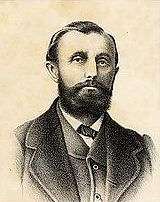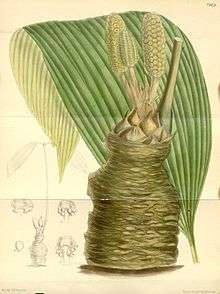Gustav Wallis
Gustav Wallis (1 May 1830 – 20 June 1878) was a German plant collector, who introduced over 1,000 plant species to Europe, many of which were named after him.

Early life
Wallis was born in Lüneburg, in Lower Saxony, Germany, where his father was an advocate.[1] Wallis was deaf and mute until six years of age, and it was not until 1836 that he was able to talk. As a consequence, he suffered from a speech defect during his entire life.[2]
In about 1836 his father died, leaving his mother a widow with six children.[1] With no means of support, she found it necessary to leave Lüneburg and move to Detmold, her native town. It was here that Wallis attended school and, in the surrounding mountains and forests, developed the love of nature and botany which later gave him the desire to travel abroad and visit the tropics.[2] As a youth, Wallis had great energy and an indomitable will, and despite his speech impediment he acquired considerable proficiency in foreign languages, an accomplishment which stood him in good stead during the course of his career.[1]
At the age of sixteen he was apprenticed to a goldsmith but, disliking the work, he quit and took an apprenticeship with a gardener at Detmold. At the end of his apprenticeship, he obtained employment in Munich, from where he often visited the Alps to collect and study plants.[1]
In 1856, Wallis went to southern Brazil, where he set up a horticultural establishment for a German firm but, following the bankruptcy of the parent company, the branch was forced to close and Wallis was left practically penniless.[3]
Jean Linden
In 1858, he was engaged as a plant-collector by Jean Linden’s orchid company, L’Horticulture Internationale, of Brussels. Wallis then began a hazardous journey, crossing the continent of South America, starting at the mouth of the River Amazon and traversing the total length to its source, exploring the river and many of its more important tributaries.[3]
In 1866, Wallis was exploring the low-lying areas where the Rio Negro meets the Amazon, when he came across an unknown Cattleya species growing among the branches of macucus trees. Wallis was able to send a large shipment to Linden, who named the new species Cattleya eldorado, and the following year had more than 700 plants of the new species in bloom on display in Paris.[4]
James Veitch & Sons
In 1870, he was engaged by James Veitch & Sons, of Chelsea, London who sent him to the Philippines to search for orchids of the Phalaenopsis species which were indigenous to those islands. Although he was able to make sufficient finds to send a shipment back to England, including Paphiopedilum argus,[5] P. haynaldianum,[6] Dendrobium amethystoglossum[7] and Lilium philippinense,[8] the mission proved too expensive to be considered a success and Wallis had to be recalled.[3]
In December 1872, he was sent to Colombia, where he had explored previously, returning in 1874 with many finds, including two giant-leaved Anthuriums, A. veitchii[3] and A. warocqueanum, as well as several interesting and valuable orchids, including various species of Masdevallia.[3]
Later career and death
His contract with Veitch was terminated in 1874, but he continued to collect plants in South America at his own expense, commencing his last journey at the end of the summer of 1875, when he left to explore the northern and central regions of the continent.[3] Whilst in Colombia, he discovered Zamia wallisii but his samples were lost; it was only in the 1980s that the plant was re-located.[9]
He was next heard of in Panama, dangerously ill with yellow fever and malaria.[10] He recovered from his illness and was able to re-commence work, but his second attack, combined with dysentery, proved fatal. His last letter was dated Cuenca, Ecuador, 24 March 1878, where, according to the collector Edward Klaboch, Wallis died in hospital on 20 June.[11]
Honours

Amongst the plants named after Wallis are:
- Anthurium wallisii[11]
- Batemannia wallisii[11]
- Calathea wallisii[12]
- Dieffenbachia seguine subvar. wallisii[11]
- Dracula wallisii[13]
- Epidendrum wallisii[11][13]
- Grammatophyllum wallisii[14][15]
- Homalomena wallisii[16]
- Houlletia wallisii[2][13]
- Masdevallia wallisii[11]
- Odontoglossum wallisii[17]
- Spathiphyllum wallisii[18]
- Stenospermation wallisii[11]
- Zamia wallisii[9]
References
- James Herbert Veitch (2006). Hortus Veitchii (reprint ed.). Caradoc Doy. p. 62. ISBN 0-9553515-0-2.
- "Gustave Wallis (1830 – 1878)". www.orchids.co.in. Retrieved 2 November 2008.
- Hortus Veitchii. p. 63.
- A.A. Chadwick (June 2002). "Cattleya eldorado". www.chadwickorchids.com. Retrieved 12 October 2010.
- Hortus Veitchii. p. 122.
- Hortus Veitchii. p. 123.
- Hortus Veitchii. p. 125.
- Hortus Veitchii. p. 450.
- Ken Hill. "Zamia wallisii". The Cycad Pages (Royal Botanic Gardens, Sydney). Retrieved 2 November 2008.
- Jorge Mario Munera (Winter 2005). "The Tragic Saga of the Scorpion Flower". Harvard University. Archived from the original on 7 July 2010. Retrieved 13 October 2010.
- Hortus Veitchii. p. 64.
- "Calathea wallisii". Germplasm Resources Information Network (GRIN). Agricultural Research Service (ARS), United States Department of Agriculture (USDA). Retrieved 2 November 2008.
- Mary E. Gerritsen & Ron Parsons (2005). Masdevallias. Timber Press. pp. 20–21.
- Steenis, C. G. G. J. van. "Flora Malesiana. general editor, C.G.G.J. van Steenis. Series I, Spermatophyta /". Djakarta :Noordhoff-Kolff,1950-. Retrieved 8 April 2015.
- H.G. Reichenbach f. Orchideae Wallisianae novae. Linnaea vol.41: 99-118 1877
- David Scherberich. "Homalomena wallisii Regel". www.aroidpictures.fr. Archived from the original on 20 November 2008. Retrieved 2 November 2008.
- Nicole Ceulemans. "Jean Linden – explorer and horticulturist". www.jeanlinden.info. Retrieved 2 November 2008.
- "Spathiphyllum wallisii". www.flickr.com. Retrieved 2 November 2008.
- IPNI. Wallis.